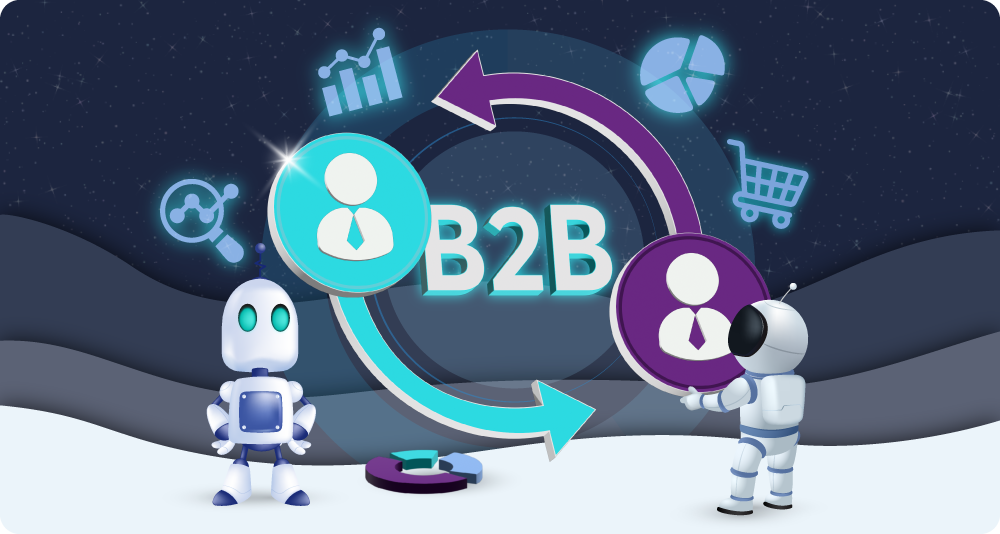

Content Marketing for B2B: Strategies and Best Practices
B2B vs B2C
A business’s target audience is one of the most crucial factors in determining a business’s marketing strategy. This is demonstrated clearly by the differences between B2B and B2C companies:
While B2B (business-to-business) companies primarily sell products or services to other businesses, B2C (business-to-consumer) companies target the wider public.
As a result of this key difference, B2B and B2C businesses find themselves in distinctly unique realms, requiring contrasting marketing approaches. So, how exactly do these differences play out?
First of all, B2B companies typically engage in longer sales cycles – often spanning several months. These negotiations can be complex and, therefore, require careful consideration by stakeholders. (This relates to another difference – B2B purchasing decisions are often made by a team of people rather than an individual.)
Another key difference between these business types is the cost involved. Since B2B transactions are typically expensive, marketing material should showcase incentives backed up by data. Similarly, B2B marketing efforts often must focus on building relationships if they are to persuade leads to spend so much of their money. In addition, B2B buyers often want to see educational content to convince them to invest in niche services.
Speaking of nicheness, B2B target audiences are usually very specific. This means B2B audience segmentation needs to be more precise, as well as affecting many other lead generation efforts. Perhaps as a result of this issue, B2B efforts are more likely to involve webinars and in-person industry events where brands can educate leads and engage with them personally.
Commonly, sales and marketing teams collaborate closely in B2B businesses, perhaps due to the rigour of lead nurturing processes. And finally, B2B businesses are more likely to publish
Thought Leader content because it helps convey the impression of industry experts, helping them overcome many of the challenges of B2B marketing.
Due to these various differences, B2B marketing strategies look very different to those used by B2C companies.
This article will explore the ways in which you can adapt your B2B marketing strategy so that it not only captures attention but also drives meaningful engagement, fosters trust, and ultimately leads to successful business partnerships. Let’s dive in and embark on this journey into the world of B2B content marketing together:
B2B content marketing strategy best practices
Optimise content creation and distribution
Since B2B sales cycles are longer than those in the B2C realm, any content marketing efforts should be sustained throughout this extended process. This means that consistency is highly important and that a varied strategy is needed to nudge leads along the sales funnel. In addition, purchasing decisions will likely be made by a group of stakeholders, requiring that content supports decision-making right the way through.
For these reasons, relationship building is a crucial part of B2B content marketing. This differs in the realm of B2C marketing, as one-time transactions can keep businesses afloat. Conversely, B2B companies thrive on repeat business and referrals so content must connect leads and companies in meaningful ways.
To get a good start on your new content marketing strategy, you need to understand and embody your business’s unique value proposition. By identifying what sets your B2B company apart from competitors, you’ll know what you need to highlight with your content.
A fundamental (but perhaps boring) part of a successful content marketing strategy is a detailed content calendar. This may attract a big yawn, but this will help massively in the long run. After some time, you’ll know whether you’ve covered relevant topics consistently and the departments concerned will be able to keep up. It’s really important that your posting schedule is consistent because it keeps your audience engaged, and therefore builds trust and credibility.
Where you distribute your content is very important. Think about how your audience will respond to different social media platforms or paid advertising. LinkedIn is a very popular platform for B2B connections; however, some brands may prefer to operate on Instagram or Facebook – so, do your research.
Email marketing remains one of the most powerful channels for B2B content distribution. Targeted email campaigns that deliver your content directly to your audience will provide a consistent connection between you and your leads.
When it comes to content creation, we recommend utilising a mix of formats, e.g., blog posts, videos, webinars, podcasts, infographics, and reels. People and businesses have diverse preferences, and a variation of content formats can help appeal to a larger number. This doesn’t mean widening your target audience. It means catering to different learning styles so that more people are engaged.
Detailed content is highly relevant in the B2B realm. B2B buyers are looking for comprehensive resources that demonstrate what you’re offering. This means producing whitepapers, e-books, and lengthy reports that give lots of detail. The more high-quality and relevant detail you provide, the more your business appears trustworthy and knowledgeable.
Another way your content can convey this trustworthy impression is through case studies, testimonials, reviews, and success stories. Social proof is a sure-fire way to prove the legitimacy of your products or services; so, it’s worth creating content that showcases real examples of your offering’s ability to solve pain points.
Making sure your content is high quality is important in any marketing strategy. In a B2B context, this means it should be well-researched, informative, and written in a professional tone. In order for your content to give value to B2B buyers, your content should educate them. Typically, B2B leads are looking for solutions to complex problems. So, your strategy would do well to provide in-depth insights into these industry challenges.
While the most prevalent content in the B2B context is dominated by text, visual elements can be beneficial. Things like charts and infographics can be very helpful if they enhance understanding or engagement – so, use them appropriately.
Our final tip for B2B content is making use of repurposing techniques. Adapting your content to different formats and using it across multiple channels means you can maximise its utility and, therefore, create a more sustainable content strategy. Learn more about content repurposing here.
Be an industry expert
At the peak of your content marketing strategy’s success, your B2B brand will have the status of a Thought Leader.
This can be achieved by publishing insightful and relevant content that addresses industry trends, challenges, and future predictions. Any particularly knowledgeable staff members should be encouraged to contribute to industry publications and speak at conferences to enhance your brand’s credibility.
In order for your content to remain relevant, it should be consistently ahead of trends or up to date. So, make sure you’re always aware of things happening within your field. In addition, you’ll want to keep an eye on what your competitors are doing. As well as helping you to stay ahead of competitors on social media platforms, this also allows you to learn from their successes and failures to refine your own strategy.
Thought Leader content can be enhanced with collaboration. Partnering with other industry experts to co-create useful content will add credibility to it. In addition, making use of their reputation may expand your brand’s reach.
Our final word on Thought Leader content is that it should solve problems. If your content is going to highlight common challenges in the field, it should also provide solutions. This way, readers will see your brand as insightful and useful – encouraging them to engage with more of your content and boosting your brand’s reputation.
In-depth lead nurturing for complex buyer journeys
The long lead nurturing processes characteristic of B2B marketing require robust strategies if they are to keep buyers interested.
One way you can do so is to align your content with the sales funnel. At the different stages, (awareness, consideration, decision) content should be tailored to suit the lead’s circumstances. For example, they should receive educational content at the beginning of the funnel and product-focused content at the end of it.
Another way you can engage with the lead’s specific circumstances is to create buyer personas. Representing your different B2B customers, these personas should have job titles, responsibilities, pain points, and preferred content formats. Read more about buyer personas here.
Appealing to data-driven decisions
As previously mentioned, the leads of B2B marketing efforts are going to need data to make their decisions. Therefore, your content should provide the necessary insights and information to nudge these decisions along.
One way of doing this is commissioning research. Providing leads with relevant statistics can make your marketing efforts more robust and increase the likelihood of positive negotiations.
In addition, you may want to present your data in the format of infographics, which can quickly convey a message to busy leads.
Targeting niche audiences
Target audiences for B2B businesses tend to be quite niche. This means that marketers must appeal to highly specific industry challenges and pain points to capture the attention of leads. To effectively engage the right people, audience segmentation is a good idea. Segment your audience based on factors such as industry, company size, and job role. Then, create content that appeals to the specific needs of each segment.
Optimise for SEO
As always, SEO is a fundamental part of successful content marketing. Whenever creating new content, be sure it’s following SEO best practices. Conducting keyword research will help you discover keywords relevant to your niche and improve the visibility of your content in the SERPs. Learn more about optimising your content for SEO here.
Final thoughts
These content marketing tips will hopefully provide you with a comprehensive framework for a successful B2B strategy. Remember, effective B2B content marketing requires a deep understanding of your audience and a commitment to delivering valuable, relevant content consistently.
Once your strategy is up and running, remember that it shouldn’t be static. When you receive new feedback or performance data, or the market changes, be sure to adapt and evolve your approach. In addition, tracking key performance indicators (KPIs) will help you feel confident about your strategy. Read this article to learn what content marketing metrics you should monitor.











